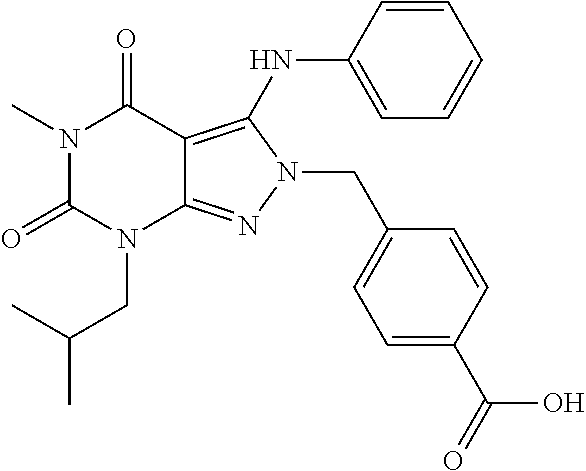Organic compounds
a phosphodiesterase inhibitor and organic compound technology, applied in the field of organic compounds, can solve the problems of decreased exercise tolerance, shortening of breath, dizziness, and death, and achieves the effects of increasing anp, bnp and cnp, reducing efficacy, and high effective antihypertensive treatmen
- Summary
- Abstract
- Description
- Claims
- Application Information
AI Technical Summary
Benefits of technology
Problems solved by technology
Method used
Image
Examples
example 1
4-((7-Isobutyl-5-methyl-4,6-dioxo-3-(phenylamino)-4,5,6,7-tetrahydropyrazolo[3,4-d]pyrimidin-2-yl)methyl)benzenesulfonamide
[0166]
[0167]A mixture of 7-isobutyl-5-methyl-3-(phenylamino)-2H-pyrazolo[3,4-d]pyrimidine-4,6(5H,7H)-dione (50 mg, 0.18 mmol), 4-(bromomethyl)benzenesulfonamide (48 mg, 0.19 mmol) and potassium carbonate (26.5 mg, 0.19 mmol) in DMF (1 mL) is stirred at room temperature for 4 days. After filtration, the filtrate is purified with a semi-preparative HPLC system equipped with a reversed-phase C18 column using a gradient of 0-75% acetonitrile in water containing 0.1% formic acid over 16 min to give 41.4 mg of product as a white solid (HPLC purity: 98%; Yield: 54%). 1H NMR (500 MHz, Chloroform-d) δ 7.79 (d, J=8.4 Hz, 2H), 7.29 (t, J=7.9 Hz, 2H), 7.13 (t, J=7.4 Hz, 1H), 7.08 (d, J=8.4 Hz, 2H), 6.91 (d, J=7.5 Hz, 2H), 6.88 (s, 1H), 4.98 (s, 2H), 4.76 (s, 2H), 3.82 (d, J=7.5 Hz, 2H), 3.34 (s, 3H), 2.41-2.20 (m, 1H), 0.97 (d, J=6.7 Hz, 6H). MS (ESI) m / z 483.1 [M+H]+.
example 2
4-((7-isobutyl-5-methyl-4,6-dioxo-3-(phenylamino)-4,5,6,7-tetrahydropyrazolo[3,4-d]pyrimidin-2-yl)methyl)benzoic acid
[0168]
[0169]A mixture of 7-isobutyl-5-methyl-3-(phenylamino)-2H-pyrazolo[3,4-d]pyrimidine-4,6(5H,7H)-dione (50 mg, 0.18 mmol), methyl 4-(bromomethyl)benzoate (44 mg, 0.19 mmol) and potassium carbonate (44.2 mg, 0.32 mmol) in DMF (1 mL) is stirred at room temperature overnight. The mixture is diluted with DMF (1 mL) followed by adding 2.5 N NaOH aqueous solution (2 mL), and then heated at 75° C. for 2 h. The mixture is neutralized with concentrated HCl and then evaporated to dryness under reduced pressure. The residue is treated with DMF and then filtered with a 0.45 μm microfilter. The filtrate is purified with a semi-preparative HPLC system equipped with a reversed-phase C18 column using a gradient of 0-85% methanol in water containing 0.1% formic acid over 16 min to give 28 mg of product as a white solid (HPLC purity: 97%; Yield: 39%). 1H NMR (500 MHz, Chloroform-d...
example 3
4-((3-(4-Fluorophenylamino)-5-methyl-7-neopentyl-4,6-dioxo-4,5,6,7-tetrahydropyrazolo[3,4-d]pyrimidin-2-yl)methyl)benzenesulfonamide
[0170]
(a) 4-((5-Methyl-7-neopentyl-4,6-dioxo-4,5,6,7-tetrahydropyrazolo[3,4-d]pyrimidin-2-yl)methyl)benzenesulfonamide
[0171]A mixture of 5-methyl-7-neopentyl-2H-pyrazolo[3,4-d]pyrimidine-4,6(5H,7H)-dione (708 mg, 3.0 mmol), 4-(bromomethyl)benzenesulfonamide (750 mg, 3.0 mmol) and potassium carbonate (1.24 g, 9.0 mmol) in DMF (15 mL) is stirred at room temperature for 6h. The mixture is diluted with water (120 mL) and then extracted with 10% MeOH in CH2Cl2 five times. The combined organic phase is evaporated to dryness to give 1.4 g of crude product as an off-white solid, which is used in the next step without further purification. MS (ESI) m / z 406.2 [M+H]+.
(b) 4-((3-Chloro-5-methyl-7-neopentyl-4,6-dioxo-4,5,6,7-tetrahydropyrazolo[3,4-d]pyrimidin-2-yl)methyl)benzenesulfonamide
[0172]To a solution of the crude 4-((5-methyl-7-neopentyl-4,6-dioxo-4,5,6,7-tet...
PUM
| Property | Measurement | Unit |
|---|---|---|
| temperature | aaaaa | aaaaa |
| temperature | aaaaa | aaaaa |
| pH | aaaaa | aaaaa |
Abstract
Description
Claims
Application Information
 Login to View More
Login to View More - R&D
- Intellectual Property
- Life Sciences
- Materials
- Tech Scout
- Unparalleled Data Quality
- Higher Quality Content
- 60% Fewer Hallucinations
Browse by: Latest US Patents, China's latest patents, Technical Efficacy Thesaurus, Application Domain, Technology Topic, Popular Technical Reports.
© 2025 PatSnap. All rights reserved.Legal|Privacy policy|Modern Slavery Act Transparency Statement|Sitemap|About US| Contact US: help@patsnap.com



